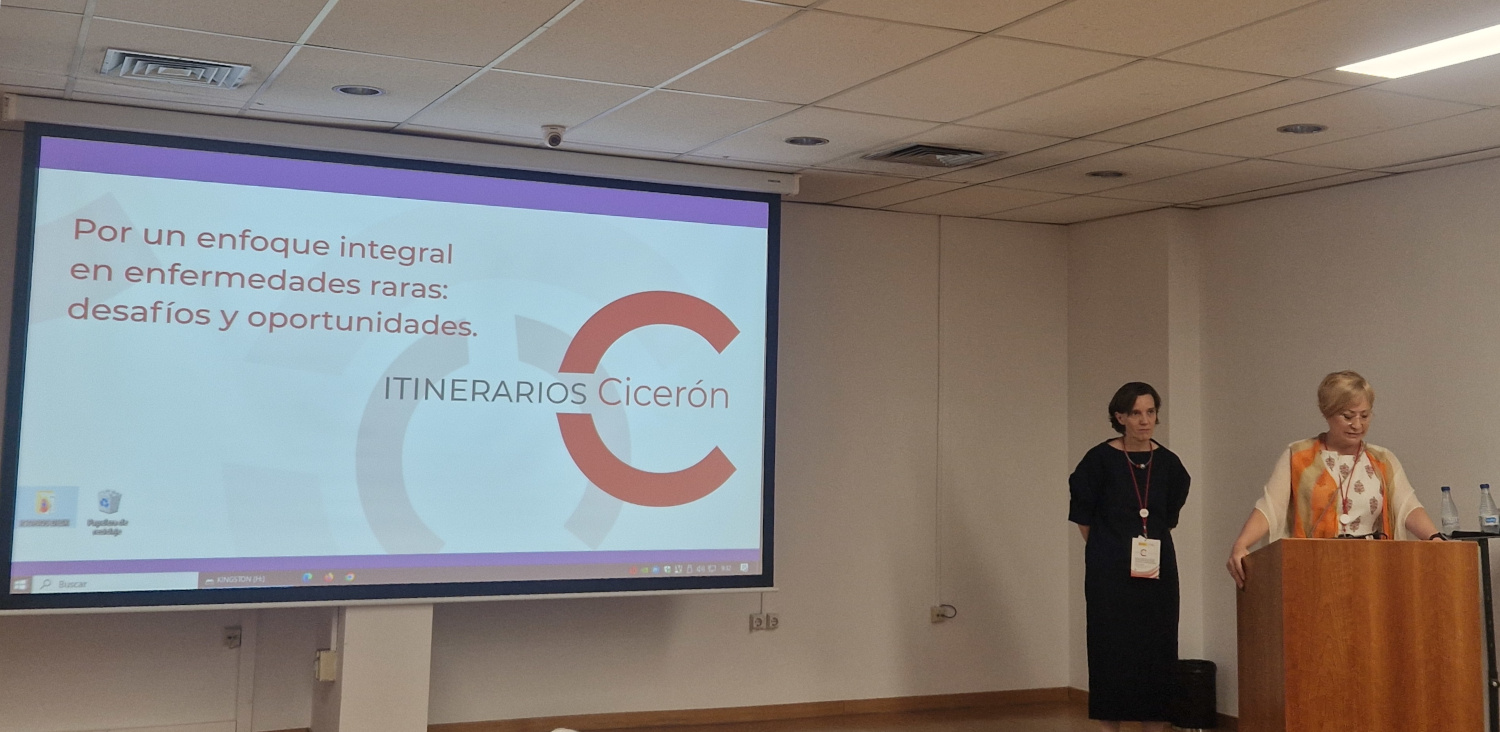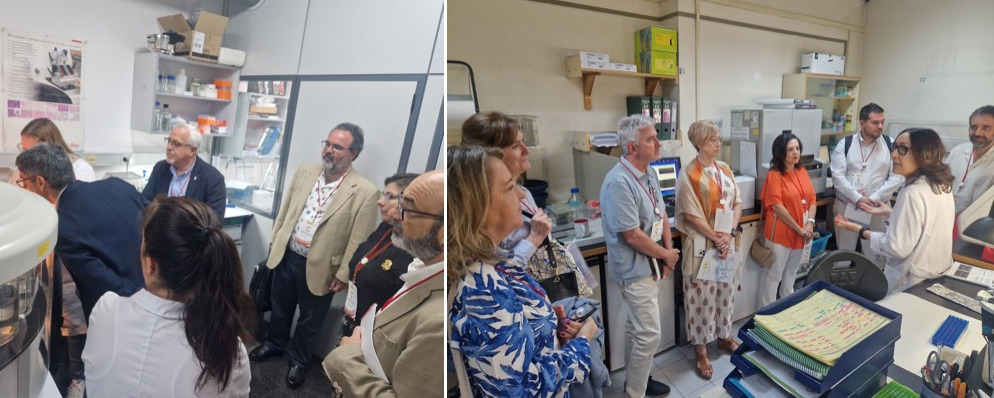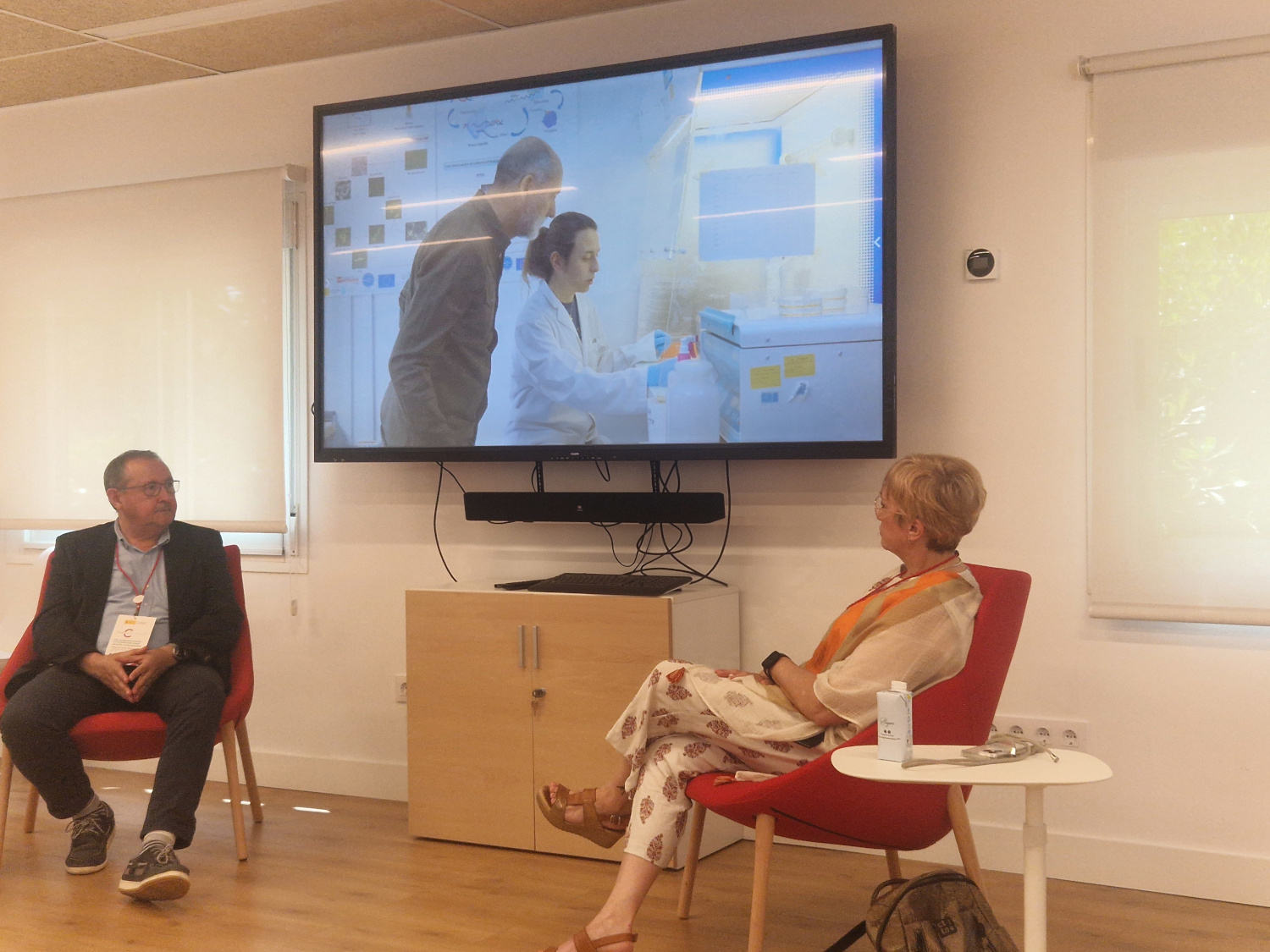- The IIBM hosted the Itinerario Cicerón “Por un enfoque integral en enfermedades raras: desafíos y oportunidades,” organized by the Red de Enfermedades Raras del CSIC, to foster dialogue among researchers, industry, patients, public administrations, and the media, and to highlight the CSIC’s contributions to rare-disease research
Research on rare diseases took center stage in a new edition of the Itinerario Cicerón of the Consejo Superior de Investigaciones Científicas (CSIC). Two years ago, the CSIC launched the Cicerón program—a series of thematic sessions that invite representatives of public administrations, industry, and the press to visit its centers and see firsthand how CSIC scientists address key scientific and social challenges.
As part of its Biomedicine Plan, the CSIC supported the creation of the Red de Enfermedades Raras (RER-CSIC) to accelerate research into these pathologies and encourage collaboration among the institution’s scientists studying any of the more than 7,000 recognized rare diseases. Such conditions affect roughly 300 million people worldwide and three million in Spain. The RER-CSIC is coordinated by Pilar López Larrubia, director of the Instituto de Investigaciones Biomédicas Sols-Morreale (IIBM, CSIC-UAM), and Pascual Sanz of the Instituto de Biomedicina de Valencia (IBV, CSIC). It now brings together 131 CSIC research groups across every area and region of the country.
On Friday, June 6, the Itinerario Cicerón titled “Por un enfoque integral en enfermedades raras: desafíos y oportunidades,” organized by the RER-CSIC, took place with the goal of bringing the work of all these CSIC groups closer to society. The initiative aimed to foster multidisciplinary understanding of these pathologies and respond to growing public concern about the care needs of patients with rare diseases.
The event, held at two venues—the IIBM and Espacio Converge—brought together CSIC researchers; representatives from the media (EFE, Diario Médico); regional officials from the Dirección General de Investigación e Innovación Tecnológica of the Community of Madrid; and industry stakeholders from Takeda and Sanofi. Also participating were the scientific director of the Centro de Investigación Biomédica en Red de Enfermedades Raras (CIBERER); the director of the Asociación Española de Laboratorios de Medicamentos Huérfanos y Ultrahuérfanos (AELMHU); the president and director of Fundación Isabel Gemio; the vice president of the Asociación de Ciencia en el Parlamento; institutional representatives from the Universidad Autónoma de Madrid (including the dean of the Faculty of Medicine); and CSIC leadership (the vice president for Innovation and Transfer, the vice president for Scientific and Technical Research, the Presidential Advisory Board, the CSIC delegate in the Community of Madrid) as well as the rest of the RER-CSIC Executive Committee.

The first session was hosted at the IIBM and opened with a welcome by Ana Castro, CSIC Vice President for Innovation and Transfer, and Pilar López Larrubia, IIBM Director. Ana Castro described the purpose of the Itinerarios Cicerón, emphasizing the importance of creating a space for reflection and collaboration to tackle social challenges. She encouraged participants to join the CSIC research network that forms the RER-CSIC “to grow and advance together,” she added.
Pilar López Larrubia underscored the value of uniting all CSIC groups working on rare diseases to deepen understanding of their pathophysiology, improve diagnostic methods, and increase the number of patients who can benefit from effective therapies.
After the institutional welcome, attendees split into three groups to tour five core scientific and technical services at the IIBM: the Sebastián Cerdán Biomedical NMR Facility, Genomics, Histology, Microscopy, and Noninvasive Neurofunctional Assessment. These visits highlighted the support and advisory roles these services provide to the center’s researchers.

Por un enfoque integral en enfermedades raras: Desafíos y oportunidades
The scientific session took place at Espacio Converge, the CSIC’s open-innovation hub. “I’m thrilled to continue the Itinerario Cicerón in this space designed for collaboration and strengthening ties with companies, associations, and other institutions,” said Ana Castro as she welcomed participants.
In this second segment, the presentation video for the Itinerario Cicerón—“Por un enfoque integral en enfermedades raras: desafíos y oportunidades”—was screened, followed by pre-recorded videos (the links can be found at the end) from the six participating researchers. After each, moderators Pilar López Larrubia and Pascual Sanz posed targeted questions to the speakers.
The six RER-CSIC investigators then summarized their main research lines:
- Luisa Botella (Centro de Investigaciones Biológicas Margarita Salas – CIB-CSIC, Madrid) on personalized research in vascular rare diseases through a multidisciplinary approach involving researchers, clinicians, and patients.
- Lluís Montoliu (Centro Nacional de Biotecnología – CNB-CSIC, Madrid) on animal models used to explore rare-disease pathophysiology, with a special focus on albinism.
- Belén Pérez (Centro de Biología Molecular Severo Ochoa – CBM, CSIC-UAM, Madrid) on current advances in hereditary metabolic diseases, emphasizing the critical importance of early diagnosis.
- Pascual Sanz (Instituto de Biomedicina de Valencia – IBV-CSIC, Valencia) on his studies of Lafora disease, an ultra-rare form of progressive myoclonic epilepsy.
- María Ángeles Balboa (Instituto de Biomedicina y Genética Molecular – IBGM, CSIC-UVa, Valladolid) on the role of lipids in autoinflammatory rare diseases such as Majeed syndrome.
- Ricardo Escalante (IIBM, Madrid) on the autophagy process and its implication in conditions like BPAN, and the cellular models used in his laboratory.

Following the presentations, an open forum moderated by Pilar López Larrubia and Pascual Sanz addressed key topics: drug repurposing, the application of artificial intelligence in biomedicine, the need to reduce therapy costs for patient accessibility, and the importance of involving patients alongside researchers and clinicians in decision-making. “We must put the patient at the center,” emphasized Jorge Javier Cebolla of Takeda. Representatives from EFE and Diario Médico also spoke, expressing gratitude for the invitation and underscoring the value of direct, rigorous information from the researchers themselves. Isabel Varela, Presidential Advisory Board member of the CSIC, congratulated the organizers and attendees for their commitment and the scientific excellence of the session. Isabel Gemio, president of the Fundación Isabel Gemio, highlighted the importance of bringing science closer to citizens so they can lend their support, noting “there is a lack of awareness about research at all levels—from policymakers and business leaders to the average citizen.”
The debate closed with remarks from Pilar López Larrubia, who thanked all participants for their presence and engagement in the discussion.
With this latest edition of the Itinerario Cicerón, the CSIC reaffirms its institutional commitment to rare-disease research and the dissemination of its advances, promoting multisector collaboration to face challenges and seize the opportunities this scientific field presents.
Luisa Botella: https://www.youtube.com/watch?v=qmAGAQOmf8Qlist=PL1RYaFqQfNGTZG0rpRKjMJAXQRgaP_-nR&index=86
Lluís Montoliu: https://www.youtube.com/watch?v=_jTN-XQe_BU&list=PL1RYaFqQfNGTZG0rpRKjMJAXQRgaP_-nR&index=87
Belén Pérez: https://www.youtube.com/watch?v=E9qes6JnAv8&list=PL1RYaFqQfNGTZG0rpRKjMJAXQRgaP_-nR&index=88
Pascual Sanz: https://www.youtube.com/watch?v=dZ1aBj_c7kg&list=PL1RYaFqQfNGTZG0rpRKjMJAXQRgaP_-nR&index=89
María Ángeles Balboa: https://www.youtube.com/watch?v=WU0Szp6h57M&list=PL1RYaFqQfNGTZG0rpRKjMJAXQRgaP_-nR&index=90
Ricardo Escalante: https://www.youtube.com/watch?v=cscfPy6Ce0w&list=PL1RYaFqQfNGTZG0rpRKjMJAXQRgaP_-nR&index=91